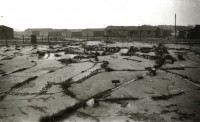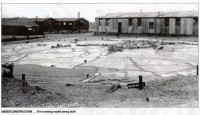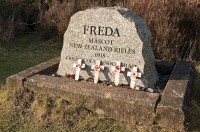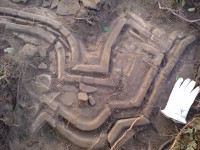 Preparatory work began yesterday to excavate a scale model of the battlefield of Messines, Belgium, built at Cannock Chase, Staffordshire, by German prisoners of war in 1917. This is one of the most complete World War I site remaining in England. The dig starts next week and will continue into October. Once it has been thoroughly recorded, the original model will be reburied for its own preservation.
Preparatory work began yesterday to excavate a scale model of the battlefield of Messines, Belgium, built at Cannock Chase, Staffordshire, by German prisoners of war in 1917. This is one of the most complete World War I site remaining in England. The dig starts next week and will continue into October. Once it has been thoroughly recorded, the original model will be reburied for its own preservation.
Cannock Chase was the site of two training camps, Brocton and Rugeley, that were built to house and train 20,000 men each, the size of a standard infantry division. Half a million troops from all over the empire passed through these camps between 1915 and 1918, spending several months learning how to fight in the trenches of the Western Front. In September of 1917, the 5th Battalion of the New Zealand Rifle Brigade (NZRB) arrived at Brocton fresh from the trenches to train new soldiers, as they themselves had been trained in the same camp when their division was formed in May of 1915.
 The New Zealand Division of the II ANZAC Corps had suffered 4,978 casualties fighting to capture the German defenses on high ground south of Ypres during the Battle of Messines Ridge (June 7th-14th, 1917). To convey the realities of the battle to the men they were tasked to train, the NZRB designed a scale terrain model of the section of the front they had successfully captured. Using trench maps, aerial photographs and their own first-hand knowledge, they designed a highly accurate model of the Messines trenches, roads, railways, village buildings, topographical contours, everything tactically relevant.
The New Zealand Division of the II ANZAC Corps had suffered 4,978 casualties fighting to capture the German defenses on high ground south of Ypres during the Battle of Messines Ridge (June 7th-14th, 1917). To convey the realities of the battle to the men they were tasked to train, the NZRB designed a scale terrain model of the section of the front they had successfully captured. Using trench maps, aerial photographs and their own first-hand knowledge, they designed a highly accurate model of the Messines trenches, roads, railways, village buildings, topographical contours, everything tactically relevant.
The finished product, built by German prisoners from a nearby POW camp, was about the size of a tennis court and surrounded on three sides by a viewing platform where trainees could watch and learn. The model was made out concrete. Gaps filled with Bunter pebbles represented roads while weed-filled gaps acted as contour lines. Bricks played the part of buildings. The trenches were modeled in the most detail, every curve, corner and turn recreated in concrete. The precision of the model and the practical training it made possible doubtless helped save lives.
 The Great War was winding down when the New Zealanders were struck with an even deadlier enemy: the 1918 Spanish influenza pandemic which killed an estimated 50 million people worldwide. Fifty of them were members of the New Zealand Rifle Brigade stationed at Brocton camp. They are buried in the Cannock Chase War Cemetery. The battalion mascot, a Harlequin Great Dane named Freda, also died in late 1918 and is buried in a Cannock Chase field.
The Great War was winding down when the New Zealanders were struck with an even deadlier enemy: the 1918 Spanish influenza pandemic which killed an estimated 50 million people worldwide. Fifty of them were members of the New Zealand Rifle Brigade stationed at Brocton camp. They are buried in the Cannock Chase War Cemetery. The battalion mascot, a Harlequin Great Dane named Freda, also died in late 1918 and is buried in a Cannock Chase field.
The last of the New Zealanders left the camp barracks in May of 1919. The camps were dismantled and sold for parts, but the model was left alone. The soldiers had given it to the people of Staffordshire at a goodbye ceremony before their departure, so the mini-Messines ridge was the only thing that was not auctioned off. Eventually it was buried to ensure it was not destroyed by the elements and people of ill-intent.
 Now the Messines model will see the light again for the first time in years, albeit for a very short time. Once it has been thoroughly recorded, a replica of the model or digital recreation will be installed in the Marquis Drive Visitors’ Centre to help explain how it was used in training. A reconstructed cabin from the camp at the visitors’ center already includes information about the Messines model drawn from period pictures and recent exploratory excavations.
Now the Messines model will see the light again for the first time in years, albeit for a very short time. Once it has been thoroughly recorded, a replica of the model or digital recreation will be installed in the Marquis Drive Visitors’ Centre to help explain how it was used in training. A reconstructed cabin from the camp at the visitors’ center already includes information about the Messines model drawn from period pictures and recent exploratory excavations.
The Staffordshire County Council expects the site and recreated model will play a part in the events commemorating the 100th anniversary of the start of World War I next year. The county has extensive plans for the centenary. Earlier this summer the council received a grant of £80,000 ($124,440) to create a Staffordshire Great War Trail, an ambition project to emphasize Staffordshire’s World War I history by bringing attention to relevant locations and institutions and by digitizing archives and individual memories of the war.
This BBC story from last year has some great views of Cannock Chase and pictures of the camp during the war.
[youtube=http://youtu.be/uYrGCuTGlz4&w=430]